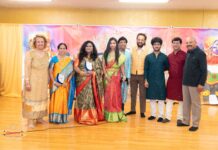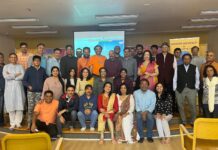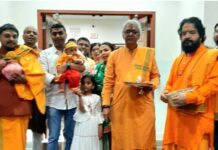
CHICAGO: Center for South Asian and Middle Eastern Studies (CSAMES) at the University of Illinois at Urbana Champaign (UIUC) hosted an all-day multidisciplinary conference on October 9 on “The Ganga (Ganges), National River of India: Its Heritage and Future.”
The symposium brought together presentations on the Ganga’s multi-faceted heritage, threats to its sustenance, and planning initiatives to conserve it. Researchers from various UIUC depts. were joined by speakers from other U.S. universities, and the audience included members of the local Indian community.
“Rarely has any river gathered in itself so much meaning and reverence as the Ganga has over three millennia. This heritage is at stake as the polluted Ganga, dammed and channelized, begins to fail in its role of sustaining cultural practices, artistic traditions, and worship rituals, and to lose thereby its centrality in the cultural and religious imagination of India.
“The efforts by the Indian government to clean the Ganga since the mid-1980s have achieved only mixed results and are widely considered being failures,” stated the conference prospectus aiming “to develop an integrated conservation framework that addresses environmental pollution, urban degradation, and vanishing sites of memory.”
Among topics addressed by the four panels were water management, religious aesthetics, riverine architecture, sacred geography, life and death along the ghats (stepped landings to the Ganga). Lively discussion and Q&A throughout the day continued over dinner among speakers, organizers and guests.
Trevor Birkenholtz and Anthony Acciavati spoke respectively on India’s national river-linking project and the proliferation of tube wells along the Ganga watershed. While detailing the centrality of water-resources to India’s future, they also highlighted the challenges, costs, risks and unintended consequences of such massive attempts to dominate the natural environment.
While Jessica Vantine Birkenholtz highlighted the uniqueness of Ganga vis-à-vis the better known Hindu goddesses (Durga, Lakshmi, etc.), Pradeep Dhillon showed how modern and contemporary artists had sought, in different ways, to capture the essence of Banaras on canvas.
Questions were raised on a possible ‘dark side’ to the nurturing river-goddess and the applicability of relatively recent Western aesthetic norms to a sacred city with such an ancient (pre-) history.
Ranjit Makkuni’s video “The Crossing: Life, Death, and Transformation” highlighted his pioneering exhibition of the Banarasi religio-cultural heritage that sought to “rematerialize its symbolic world through computer technology,” which can ensure the vanishing past a global future.
World-renowned cultural geographer of the sacred city from Banaras Hindu University, Rana P.B.
Singh, showed how the apparently haphazard distribution of temples and pilgrimage sites associated with sun worship were astronomically correlated to the movement of the celestial body and curvature of the Ganga.
Swati Chattopadhyay, by contrast, argued that the riverine aesthetics as revealed in British paintings of the ghat architecture, especially in Bengal, could be understood as display and confirmation of colonial power.
Kelly Alley, Alpa Nawre and conference organizer Amita Sinha focused on the endangered ghats. Taking on governance, Alley expressed skepticism regarding ambitious top-down approaches and argued for local grassroots initiatives towards rejuvenation.
Nawre emphasized how, though continuous, each ghat is not just a physical but a mental space, with its own character, atmosphere, uses, and draws its strength from its multiple activities and neighboring communities.
Sinha sought solutions for continued pollution resulting from cremation. Rana Singh observed that many practices, such as throwing remains (e.g., ashes) into the river, were not sanctioned by the scriptures: they could be abandoned while retaining the ritual symbolism.
By the end of the day, this Midwest conference bore testimony to how Ganga, sacred river of the Hindus, is increasingly capturing the global imagination.
Sunthar Visuvalingam






